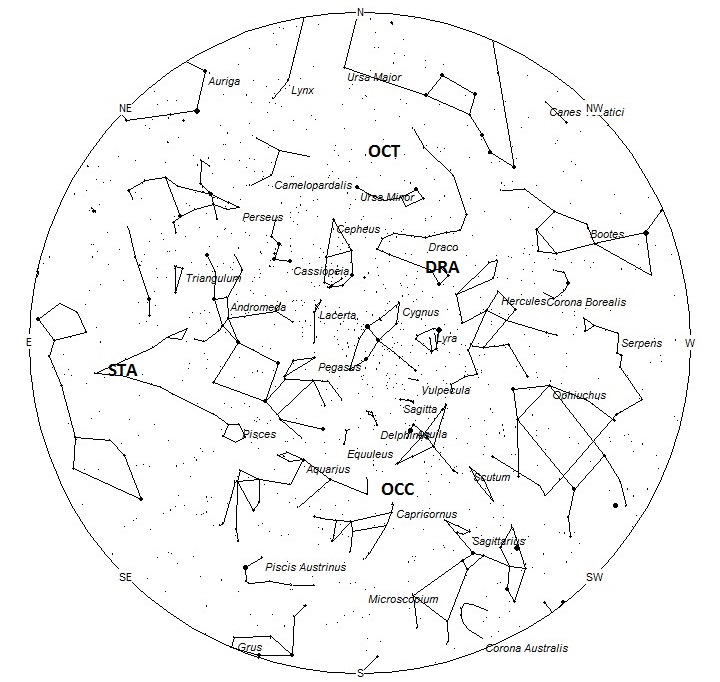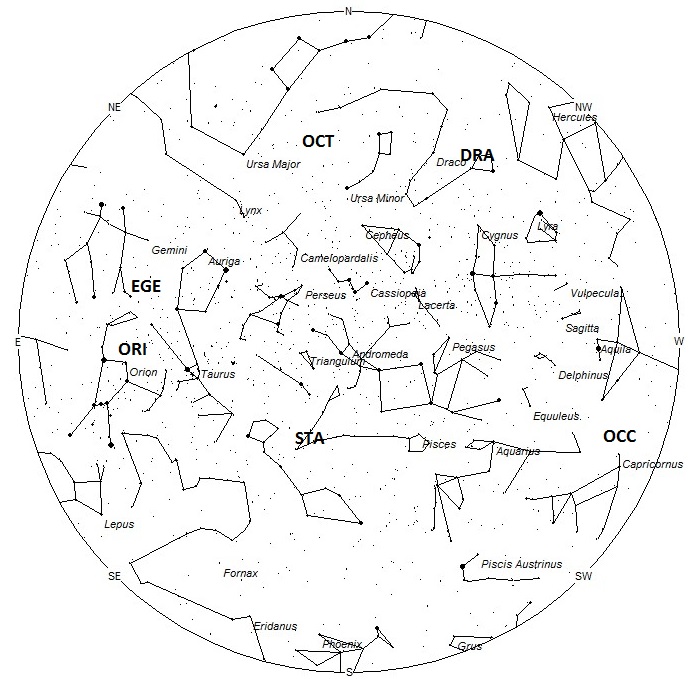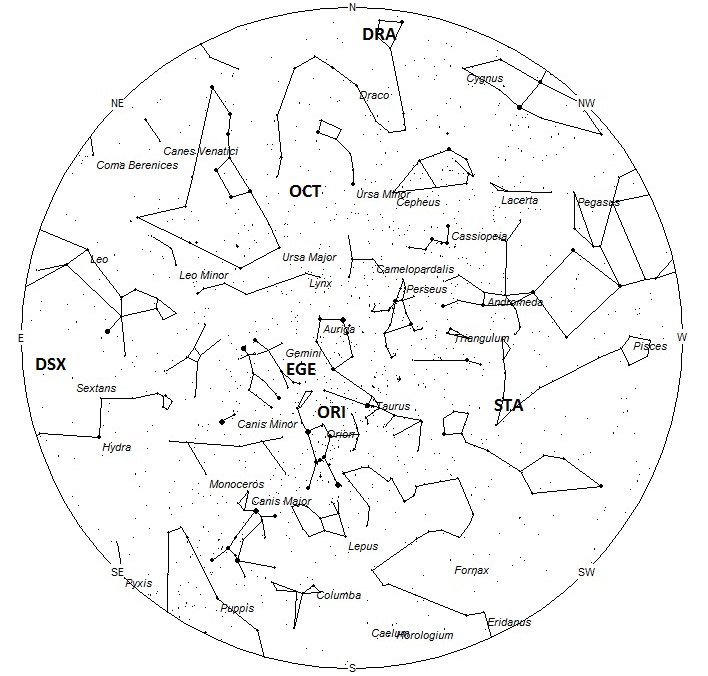Meteor activity increases in October when compared to September. A major shower (the Orionids) is active all month long and there are also many minor showers to be seen. Both branches of the Taurids become more active as the month progresses, providing slow, graceful meteors to the nighttime scene. The Orionids are the big story of the month reaching maximum activity on the 22nd. This display can be seen equally well from both hemispheres which definitely helps out observers located in the sporadic-poor southern hemisphere this time of year. Sporadic activity is still good as seen from the northern hemisphere. In the southern hemisphere though, the sporadic activity is near its annual nadir.
During this period the moon reaches it new phase on Saturday October 1st. At this time the moon will be located near the sun and will not be visible at night. As the week progresses the waxing crescent moon will enter the evening sky but will set during the evening hours, allowing a moon-free view of the more active morning hours. The estimated total hourly meteor rates for evening observers this week is near 4 as seen from mid-northern latitudes (45N) and 3 as seen from tropical southern locations (25S). For morning observers the estimated total hourly rates should be near 18 as seen from mid-northern latitudes (45N) and 13 as seen from tropical southern locations (25S). The actual rates will also depend on factors such as personal light and motion perception, local weather conditions, alertness and experience in watching meteor activity. Note that the hourly rates listed below are estimates as viewed from dark sky sites away from urban light sources. Observers viewing from urban areas will see less activity as only the brightest meteors will be visible from such locations.
The radiant (the area of the sky where meteors appear to shoot from) positions and rates listed below are exact for Saturday night/Sunday morning October 1/2 These positions do not change greatly day to day so the listed coordinates may be used during this entire period. Most star atlases (available at science stores and planetariums) will provide maps with grid lines of the celestial coordinates so that you may find out exactly where these positions are located in the sky. A planisphere or computer planetarium program is also useful in showing the sky at any time of night on any date of the year. Activity from each radiant is best seen when it is positioned highest in the sky, either due north or south along the meridian, depending on your latitude. It must be remembered that meteor activity is rarely seen at the radiant position. Rather they shoot outwards from the radiant so it is best to center your field of view so that the radiant lies at the edge and not the center. Viewing there will allow you to easily trace the path of each meteor back to the radiant (if it is a shower member) or in another direction if it is a sporadic. Meteor activity is not seen from radiants that are located below the horizon. The positions below are listed in a west to east manner in order of right ascension (celestial longitude). The positions listed first are located further west therefore are accessible earlier in the night while those listed further down the list rise later in the night.
These sources of meteoric activity are expected to be active this week.
The Draconids (GIA) are expected to be active on five evenings from October 5-9. Maximum activity is expected to occur on October 8. The radiant lies at 17:28 (262) +56. This position lies in southeastern Draco, very close to the position occupied by the faint star known as Kuma (Nu Draconis). This activity is best seen just as soon as it becomes totally dark. The expected hourly rates are a guess ranging from 0-5, most likely 0-1. With an entry velocity of 19 km/sec., the average Draconid meteor would be of very slow velocity. These meteors are poorly seen from the southern hemisphere due to the low radiant altitude seen from below the equator.
Experienced observers are urged to be on the lookout for any activity from the October Capricornids (OCC). These meteors are possibly related to lost comet D/1978 R1 (Haneda-Campos). If the comet still exists it would reach perihelion in November 2016. A moderate display of bright meteors was seen from Australia on October 3, 1972. Other attempts at observing these meteors were less successful. With a favorable lack of moonlight in the evening sky during this period, observers are urged to monitor the evening sky this week for any very slow meteors radiating from the border of Capricornus and Aquila near the position 20:06 (302) -09. This position is roughly 5 degrees northwest of the naked eye double star known as Algedi (alpha2 Capricorni). This position is best placed near 2000 (8pm) when the radiant lies highest above the horizon. While this area of the sky is fairly well placed for northern observers, it is much more favorably placed for those south of the equator where it lies much higher in the sky. Like the Daytime Sextantids mentioned below, any observations of these stream (either positive or negative) would be important to our understanding of these streams. Maximum activity is predicted to occur on October 2nd.
The Southern Taurids (STA) are active from a large radiant centered near 01:44 (026) +07. This position lies in southeastern Pisces, directly between a pair of 4th magnitude stars known as nu and omicron Piscium. These meteors may be seen all night long but the radiant is best placed near 0200 local summer time (LST) when it lies on the meridian and is located highest in the sky. Rates at this time should be near 3 per hour regardless of your location. With an entry velocity of 29 km/sec., the average Southern Taurid meteor would be of slow velocity.
The Orionids (ORI) are active from a radiant located at 05:28 (082) +14, which places it in northern Orion, 4 degrees north of the 3rd magnitude star known as Meissa (lambda Orionis). This area of the sky is best placed in the sky during the last hour before dawn, when it lies highest above the horizon in a dark sky. Current rates would be near 3 per hour no matter your location. With an entry velocity of 67 km/sec., most activity from this radiant would be of swift speed.
Recent video analysis of the Epsilon Geminids (EGE) have shown that they are active as early as September 29. The current radiant position would be located near 06:04 (092) +29, which places it in southeastern Auriga, 2 degrees southwest of the 4th magnitude star known as kappa Aurigae. This area of the sky is best placed in the sky during the last hour before dawn, when it lies highest above the horizon in a dark sky. Current rates should be near 1 per hour as seen from the northern hemisphere and less than 1 when viewed from south of the equator. With an entry velocity of 70 km/sec., most activity from this radiant would be of swift speed.
The Daytime Sextantids (DSX) are not well known due to the fact that the radiant lies close to the sun and these meteors are only visible during the last couple of hours before dawn. The radiant is located at 10:28 (157) 00. This position lies in central Sextans, very close to the position occupied by the 5th magnitude star known as beta Sextantis. This position is also 15 degrees southeast of the 1st magnitude star known as Regulus (alpha Leonis). This area of the sky is best placed in the sky during the last hour before dawn, when it lies highest above the horizon in a dark sky. Current rates would be most likely less than 1 per hour no matter your location. Spotting any of this activity would be a notable accomplishment. With an entry velocity of 33km/sec., most activity from this radiant would be of medium-slow speed.
The October Camelopardalids (OCT) were first noticed by Peter Jenniskens and mentioned in his book Meteor Showers and their Parent Comets. IMO video data has confirmed this activity which is short-lived and best seen on the morning of October 5th. The radiant lies at 11:04 (166) +79, which places it in a very remote portion of eastern Camelopardalis. The easiest way to pinpoint this radiant is to draw a line through the bottom of the “Little Dipper” (Gamma and Beta Ursae Minoris) westward. Draw another line from the “pointers” in the “Big Dipper” (Alpha and Beta Ursae Majoris) and extend it northward Polaris. Where these 2 lines intersect will be close to the OCT radiant. This area of the sky is above the horizon most of the night for most observers in the northern hemisphere but is best placed in the sky during the last hour before dawn, when it lies highest above the horizon. Rates at maximum would be near 1 per hour as seen from the northern hemisphere. These meteors are basically invisible from locations south of the equator. With an entry velocity of 47 km/sec., most activity from this radiant would be of medium velocity.
As seen from the mid-northern hemisphere (45N) one would expect to see approximately 10 sporadic meteors per hour during the last hour before dawn as seen from rural observing sites. Evening rates would be near 3 per hour. As seen from the tropical southern latitudes (25S), morning rates would be near 7 per hour as seen from rural observing sites and 2 per hour during the evening hours. Locations between these two extremes would see activity between the listed figures.
The table below presents a list of radiants that are expected to be active this week. Rates and positions are exact for Saturday night/Sunday morning except where noted in the shower descriptions.
.
| SHOWER | DATE OF MAXIMUM ACTIVITY | CELESTIAL POSITION | ENTRY VELOCITY | CULMINATION | HOURLY RATE | CLASS |
| RA (RA in Deg.) DEC | Km/Sec | Local Summer Time | North-South | |||
| Draconids (GIA) | Oct 08 | 17:28 (262) +56 | 19 | 17:00 | <1 – <1 | III |
| Oct. Capricornids (OCC) | Oct 02 | 20:06 (302) -09 | 15 | 20:00 | <1 – <1 | III |
| Southern Taurids (STA) | Oct 10 | 01:44 (026) +07 | 29 | 02:00 | 3 – 3 | II |
| Orionids (ORI) | Oct 22 | 05:28 (082) +14 | 67 | 06:00 | 3 – 3 | I |
| Epsilon Geminids (EGE) | Oct 11 | 06:04 (092) +29 | 70 | 07:00 | 1 – <1 | II |
| Daytime Sextantids (DSX) | Sep 29 | 10:28 (157) 00 | 33 | 11:00 | <1 – <1 | IV |
| Oct. Camelopardlids (OCT) | Oct 05 | 11:04 (166) +79 | 47 | 12:00 | 1 – 0 | IV |




